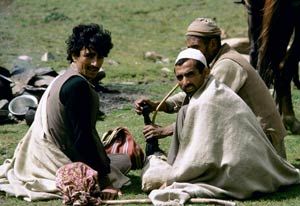Anti-smoking programs target Indian youth
March/ April 2011 | Volume 10, Issue 2
India presents a serious challenge in efforts to curb tobacco addiction. Nearly 14 percent of Indian youths, aged 13 to 15, smoke and more than 5,500 try tobacco for the first time every day. Tobacco use is especially high among low-income communities and many are beginning at age 10 or younger.
Fogarty’s tobacco program aims to support research and capacity building. In Delhi, India, Fogarty supports Project ACTIVITY, a group-randomized intervention trial designed to develop, implement and evaluate a comprehensive, community-based approach to tobacco control for youth living in urban slums. The study is being conducted with 14 low-income communities in Delhi in collaboration between a local health information group and the University of Texas. Seven slums were designated to receive a two-year intervention, with another seven serving as a comparison group.

Photo by Curt Carnemark/World Bank
Tobacco use is especially high among low-income
communities in India and young people are starting
at age 10 or even younger.
The two-year intervention targets intra-personal and socio-environmental risk factors to prevent the onset of tobacco use and promote tobacco cessation using training workshops, community-based cessation camps, interactive activities and policy enforcement. Activities include street plays, poster and slogan competitions and a “quit and win” contest. The goal is to engage young people in activities that vividly present the negative health effects of smoking, aided by young leaders in the communities already motivated to become agents of change.
“A majority of youth leaders felt that role plays were a novel and interesting way to create awareness about tobacco prevention,” said Dr. Monika Arora, the local group’s senior director.
ACTIVITY reaches out to approximately 9,000 adolescents, through multiple community based interactive activities, tobacco cessation camps and outreach programs - including counseling services - in an attempt to promote tobacco cessation among youth and adults residing in intervention communities. Overall, nearly 1,400 visited the camps and benefited from cessation strategies.
Arora said that an endline survey should be completed in June to assess the program’s impact. At the same time, focus group discussions are ongoing in the seven intervention communities to discuss the efficacy of ACTIVITY’s intervention strategies.
More Information
To view Adobe PDF files,
download current, free accessible plug-ins from Adobe's website.